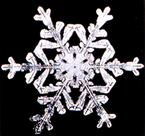User:GreatStellatedDodecahedron/History of crystallography before x-rays
The story of crystallography begins in the 17th century with the work of Kepler on the structure of snowflakes and Nicolas Steno's discovery that the angles between corresponding faces in a crystalline substance are always the same. Some sources[1][2][3] state that the history of crystallography started with the investigation of the diffraction of x-rays by Max von Laue in 1912 but that ignores the previous three centuries of scientific work in the field.
References to be used:
17th Century
[edit]- 1669 - In his book De solido intra solidum naturaliter contento[9] Nicolas Steno asserted that, although the number and size of crystal faces may vary from one crystal to another, the angles between corresponding faces are always the same. This was the original statement of the first law of crystallography (Steno's law).[10]
Conceptual developments
[edit]Crystals, though long admired for their regularity and symmetry, were not investigated scientifically until the 17th century. Johannes Kepler hypothesized in his work Strena seu de Nive Sexangula (A New Year's Gift of Hexagonal Snow) (1611) that the hexagonal symmetry of snowflake crystals was due to a regular packing of spherical water particles.[11] The Danish scientist Nicolas Steno (1669) pioneered experimental investigations of crystal symmetry. Steno showed that the angles between the faces are the same in every exemplar of a particular type of crystal.[12] René Just Haüy (1784) discovered that every face of a crystal can be described by simple stacking patterns of blocks of the same shape and size. Hence, William Hallowes Miller in 1839 was able to give each face a unique label of three small integers, the Miller indices which remain in use for identifying crystal faces. Haüy's study led to the idea that crystals are a regular three-dimensional array (a Bravais lattice) of atoms and molecules; a single unit cell is repeated indefinitely along three principal directions. In the 19th century, a complete catalog of the possible symmetries of a crystal was worked out by Johan Hessel,[13] Auguste Bravais,[14] Evgraf Fedorov,[15] Arthur Schönflies[16] and (belatedly) William Barlow (1894). Barlow proposed several crystal structures in the 1880s that were validated later by X-ray crystallography;[17] however, the available data were too scarce in the 1880s to accept his models as conclusive.
Before the development of X-ray diffraction and X-ray crystallography (see below), the study of crystals was based on physical measurements of their geometry using a goniometer.[18] This involved measuring the angles of crystal faces relative to each other and to theoretical reference axes (crystallographic axes), and establishing the symmetry of the crystal in question. The position in 3D space of each crystal face is plotted on a stereographic net such as a Wulff net or Lambert net. The pole to each face is plotted on the net. Each point is labelled with its Miller index. The final plot allows the symmetry of the crystal to be established.
X-ray crystallography
[edit]Electron crystallography
[edit]Theories and algorithms
[edit]Other crystallography
[edit]References
[edit]- ^ "Crystallography: How discovering crystal structure gave meaning to matter". Institute of Physics. Retrieved 10 May 2024.
- ^ Schwarzenbach, Dieter (January 2012). "The success story of crystallography" (PDF). Acta Crystallographica A. 68 (1): 57–67. doi:10.1107/S0108767311030303. Retrieved 10 May 2024.
- ^ "History of crystallography". British Crystallographic Association. Retrieved 10 May 2024.
- ^ Burke, John G. (1966). Origins of the science of crystals. Berkeley, CA: University of California Press. p. 198. Retrieved 10 May 2024.
- ^ Martínez-Ripoll, Martín. "The structure of crystals. Early historical notes". Crystallography-Cristalografia. CSIC. Retrieved 10 May 2024.
- ^ Authier, A. (2013). Early days of x-ray crystallography, International Union of Crystallography Texts on Crystallography, Oxford University Press, Oxford, pp. 442 ISBN 9780198754053 doi:10.1093/acprof:oso/9780199659845.001.0001
- ^ Ewald, P. P. (ed.) (1962), 50 Years of x-ray diffraction, IUCR, Oosthoek
- ^ Lima-de-Faria, José (ed.) (1990), Historical atlas of crystallography, Springer Netherlands ISBN 9780792306498
- ^ Steno, N. (1669). De solido intra solidum naturaliter contento, Star, Florence
- ^ Molčanov, Krešimir; Stilinović, Vladimir (2014). "Chemical Crystallography before X-ray Diffraction". Angewandte Chemie International Edition. 53 (3): 638–652. doi:10.1002/anie.201301319. PMID 24065378.
- ^ Kepler J (1611). Strena seu de Nive Sexangula. Frankfurt: G. Tampach. ISBN 3-321-00021-0.
- ^ Steno N (1669). De solido intra solidum naturaliter contento dissertationis prodromus. Florentiae.
- ^ Hessel JF (1831). Kristallometrie oder Kristallonomie und Kristallographie. Leipzig.
- ^ Bravais A (1850). "Mémoire sur les systèmes formés par des points distribués regulièrement sur un plan ou dans l'espace". Journal de l'École Polytechnique. 19: 1.
- ^ Shafranovskii II, Belov NV (1962). Paul Ewald (ed.). "E. S. Fedorov" (PDF). 50 Years of X-Ray Diffraction. Springer: 351. ISBN 90-277-9029-9.
- ^ Schönflies A (1891). Kristallsysteme und Kristallstruktur. Leipzig.
- ^ Barlow W (1883). "Probable nature of the internal symmetry of crystals". Nature. 29 (738): 186. Bibcode:1883Natur..29..186B. doi:10.1038/029186a0. See also Barlow W (1883). "Probable Nature of the Internal Symmetry of Crystals". Nature. 29 (739): 205. Bibcode:1883Natur..29..205B. doi:10.1038/029205a0. Sohncke L (1884). "Probable Nature of the Internal Symmetry of Crystals". Nature. 29 (747): 383. Bibcode:1884Natur..29..383S. doi:10.1038/029383a0. S2CID 4072817. Barlow WM (1884). "Probable Nature of the Internal Symmetry of Crystals". Nature. 29 (748): 404. Bibcode:1884Natur..29..404B. doi:10.1038/029404b0. S2CID 4016086.
- ^ "The Evolution of the Goniometer". Nature. 95 (2386): 564–565. 1915-07-01. Bibcode:1915Natur..95..564.. doi:10.1038/095564a0. ISSN 1476-4687.


